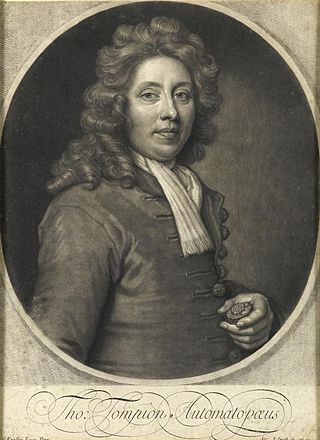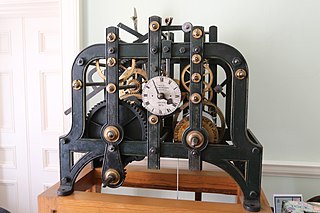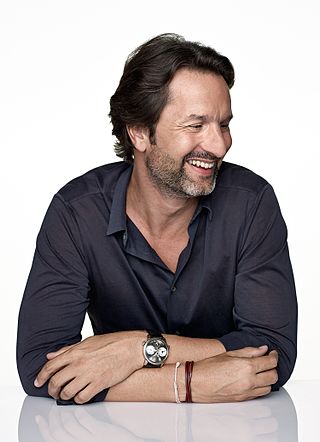Related Research Articles

Abraham-Louis Breguet, born in Neuchâtel, then a Prussian principality, was a horologist who made many innovations in the course of a career in watchmaking industry, including the tourbillon. He was the founder of the Breguet company, which is now the luxury watch division of the Swiss Swatch Group.

The Worshipful Company of Clockmakers was established under a Royal Charter granted by King Charles I in 1631. It ranks sixty-first among the livery companies of the City of London, and comes under the jurisdiction of the Privy Council. The company established a library and its museum in 1813, which is the oldest specific collection of clocks and watches worldwide. This is administered by the company's affiliated charity, the Clockmakers' Charity, and is presently housed on the second floor of London's Science Museum. The modern aims of the company and its museum are charitable and educational, in particular to promote and preserve clockmaking and watchmaking, which as of 2019 were added to the HCA Red List of Endangered Crafts.

A watchmaker is an artisan who makes and repairs watches. Since a majority of watches are now factory-made, most modern watchmakers only repair watches. However, originally they were master craftsmen who built watches, including all their parts, by hand. Modern watchmakers, when required to repair older watches, for which replacement parts may not be available, must have fabrication skills, and can typically manufacture replacements for many of the parts found in a watch. The term clockmaker refers to an equivalent occupation specializing in clocks.

Vacheron Constantin SA is a Swiss luxury watch and clock manufacturer founded in 1755. Since 1996, it has been a subsidiary of the Swiss Richemont Group. Vacheron Constantin is one of the oldest watch manufacturers in the world with an uninterrupted watchmaking history since its foundation in 1755. It employs around 1,200 people worldwide as of 2018, most of whom are based in the company's manufacturing plants in the Canton of Geneva and Vallée de Joux in Switzerland.

In horology, a tourbillon is an addition to the mechanics of a watch escapement to increase accuracy. Conceived by the British watchmaker and inventor John Arnold, it was developed by his friend the Swiss-French watchmaker Abraham-Louis Breguet and patented by Breguet on 26 June 1801. In a tourbillon the escapement and balance wheel are mounted in a rotating cage, with the goal of eliminating errors of poise in the balance giving a uniform weight.

John Arnold was an English watchmaker and inventor.

The Clockmakers’ Museum in London, England, is believed to be the oldest collection specifically of clocks and watches in the world. The collection belongs to and is administered by the Clockmakers’ Charity, affiliated to the Worshipful Company of Clockmakers, founded in 1631 by Royal Charter. Since 2015 it has been housed in a gallery provided by the Science Museum in South Kensington, having formerly been located in the Guildhall complex in the City of London since 1874, where it first opened to the public. Admission is free.

Thomas Tompion, FRS (1639–1713) was an English clockmaker, watchmaker and mechanician who is still regarded to this day as the "Father of English Clockmaking". Tompion's work includes some of the most historic and important clocks and watches in the world, and can command very high prices whenever outstanding examples appear at auction. A plaque commemorates the house he shared on Fleet Street in London with his equally famous pupil and successor George Graham.

George Daniels, CBE, FBHI, FSA, AHCI was an English horologist who was considered by some to be one of the best in the world in the field of luxury mechanical watches and timepieces during his lifetime. He was a watchmaker who all but completely built 23 pocket watches and 2 wrist watches as well as a number of clocks all by hand. Daniels commented often that "a watch has historic, intellectual, technical, aesthetic, useful and amusing qualities" and he sought to make watches that did each of these things while consistently improving on the technical and horological aspects of each watch he made. As at December 2022, George Daniels watches only sat behind Patek and Rolex watches by reference to value and number of watches sold, with 6 watches achieving prices in excess of USD$1.5 million. This makes George Daniels watches the first independently made watches to achieve this result.

The American Watchmakers-Clockmakers Institute (AWCI) is a not-for-profit trade association based in the United States that is dedicated to the advancement of the modern watch industry, from which it receives a significant portion of its funding. While the AWCI is an American organization, it also has members throughout the world.

The British Horological Institute (BHI) is the representative body of the horological industry in the United Kingdom. It was founded by a group of clockmakers in 1858, and has its current premises at Upton Hall in Nottinghamshire, which includes a museum of clock history.

The coaxial escapement is a type of modern watch escapement mechanism invented by English watchmaker George Daniels in 1976 and patented in 1980. It is one of the few watch escapements to be invented in modern times and is used in most of the mechanical watch models currently produced by Omega SA.
Jonathan Betts MBE is Curator Emeritus at the Royal Observatory, Greenwich, a horological scholar and author, and an expert on the first marine timekeepers created by John Harrison in the middle of the 18th century. He was formerly Senior Specialist in horology at Greenwich. Between 2016 and 2019 he served on the board of trustees of the Institute of Conservation.

Maîtres du Temps is a Swiss watch company. Founded in 2005 by Steven Holtzman, the brand is based in La Chaux-de-Fonds, Switzerland. The brand launched in Geneva in 2008 with Chapter One, a watch developed by Christophe Claret, Roger Dubuis and Peter Speake-Marin.
John Harwood (1893–1964) was a British watchmaker who invented a self-winding wristwatch.

Maximilian Büsser is a Swiss businessman and founder of the watch brand MB&F. Prior to his work at MB&F he was the CEO of Harry Winston Rare Timepieces (1998–2005) and worked at Jaeger-LeCoultre (1991–1998). Büsser has lived in Dubai since 2014.

Parsons Horological Institute was the first horological school in the United States. It was founded in 1886, in La Porte, Indiana. In 1898, it moved to Peoria, Illinois, eventually becoming a department of what is now Bradley University.
The Horological Society of New York (HSNY) is an American nonprofit organization dedicated to advancing the art and science of horology.
Rebecca Struthers is an English watchmaker, historian, author, engineer, and gemmologist. She works with her husband, Craig, who is a master watchmaker. She won the Heritage Crafts award in 2021, presented by King Charles III. She is the only practising watchmaker in the United Kingdom with a PhD in horology.
Henry B. Fried was an American horologist and watchmaker, who wrote the first book on repairing quartz watches.
References
- ↑ "Roger W. Smith". Tp178.com. 14 October 2002. Archived from the original on 23 July 2012. Retrieved 17 May 2013.
- ↑ "Roger W. Smith – British watchmaking is alive and (...)". Europastar.com. Retrieved 17 May 2013.
- ↑ "BBC News - The man who makes £100,000 watches". Bbc.co.uk. Retrieved 25 September 2013.
- ↑ . "The New York Watch Auction: Eight Lot 12". phillips.com. Retrieved 17 June 2023.
- ↑ Touchot, Arthur (13 September 2016). "The Road Through Britain Episode 1: Roger W. Smith". Hodinkee. Retrieved 11 October 2016.
- ↑ "Watchmaker and charity worker honoured". BBC. 11 June 2018. Retrieved 12 June 2018– via www.bbc.co.uk.
- ↑ "The Watchmaker's Apprentice". IMDb. Retrieved 12 November 2016.
- ↑ "rwsmithwatches". YouTube. Retrieved 17 May 2013.